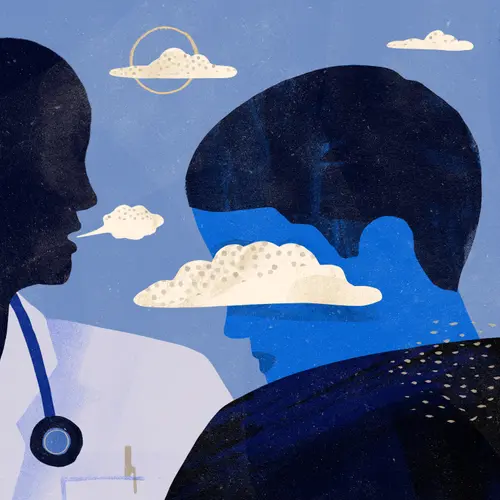Prescription opioids are usually safe when taken for a short time to help with pain. But anyone who takes opioids is at risk of developing an addiction, also known as an opioid use disorder. Regular opioid use over time can lead to dependence, as your body demands more and more of the drug. And opioid misuse can lead to a substance use disorder, overdose, and even death. Opioids, even taken as directed, can lead to these problems.
When you quit taking opioids after a period of time, it’s normal to have cravings and withdrawal symptoms if your body has become dependent on them. Knowing how to manage your opioid cravings is important, because cravings can increase your likelihood of relapse (return to using the drug) if not addressed.
If you’re thinking about stopping the use of opioids or are already trying to stop, you should know that treatment methods and programs are available to help you successfully manage the cravings as you recover.
What Are Opioid Cravings and Why Do They Occur?
A craving is a very strong urge to use the opioid. This urge may begin within hours after your last dose or as long as 2-4 days later, depending on what type and/or dose of opioid you took and when you started.
Cravings may make you feel like your whole life depends upon taking the drug again. “Craving” an opioid is not the same thing as having a strong desire to eat your favorite dessert. If you are dependent on opioids, you may go to extreme lengths to satisfy your cravings.
Opioid cravings are overwhelming because the drug activates powerful reward centers in your brain. They release “feel-good” chemicals that create a sense of pleasure and well-being.
But when you take a painkiller like oxycodone for a long time, your brain and body can get used to having the drug in your system and you build up a tolerance. When that happens, the same dose no longer makes you feel as great, so you need more to feel good. Opioid craving is one major sign of a use disorder. It’s proof the drug has changed the way your brain works to the point where it doesn’t work as well when you don’t have opioids in your system.
When you stop or try to stop taking opioids, the intense cravings you will feel may be ongoing, or caused by certain things that happen. You may have constant thoughts about the drug, for example, or you may be driving past a drug store and suddenly feel a strong craving. Cravings may also happen when you’re around certain friends you know who use the drug or are in locations where you used opioids before.
Intense opioid cravings can last 20 minutes or 2 hours. It’s different for each person, but they will go away with time if managed well.
What Works: Medication and Counseling
The most effective treatment for opioid cravings is a combination of medication and counseling. These medication-assisted treatments (MATs) help you stick with your treatment and lower your chance of relapse. Medications prescribed for MAT include:
- Methadone (Dolophine and Methadose), which can block the effects of opioids and is available in a daily dose as a liquid or pill
- Buprenorphine (Subutex, Sublocade, Brixadi), which can be taken daily orally or as a once-a-month injection
- Buprenorphine/Naloxone (Suboxone), which is a combination of buprenorphine and the overdose-reversal drug naloxone
- Naltrexone (Vivitrol), which is taken as a monthly injection
Inpatient and outpatient rehab programs can provide MAT and other treatment to help you overcome opioid cravings while you recover. Other helpful approaches include 12-step programs, individual therapy, group counseling, and what’s called a dual diagnosis approach (for those with a mental health condition in addition to an opioid issue).
What Works: Coping Skills
Another way to reduce cravings is to use specific strategies for coping with your cravings:
Distraction techniques. Try to focus your brain on something else for the 20 minutes that a craving typically lasts. This can include activities like listening to music, going for a walk, having a snack, or reading an article.
Talking to others (and with yourself). Talking about what you're struggling with is important. It reinforces the fact that your cravings are normal and won’t last forever.
“Urge Surfing.” When you’re experiencing a craving, try to remain “in the moment” and accept the feeling without trying to change it. Oddly enough, the more you do this, the less power the craving has over you.
Physical exercise. In one study, people who misused substances like opioids and other addictive drugs exercised 3 times a week for 2-6 months, with half of them reporting less substance use 1 year later. Physical workouts also can add structure to your life, provide a positive distraction, and help you build positive social connections.
When to Call Your Doctor
If you’re worried that you can’t easily quit taking opioids because you’ve developed a tolerance, ask your doctor for help tapering-off (reducing the amount of drug you take gradually). Don’t stop taking the medication on your own, because it can cause severe side effects.
If you’re living with chronic pain, opioids may not be the safest long-term treatment. Ask your doctor about less-addictive medications and other types of treatment.
Treatment Resources
If you need help locating a doctor in your area who’s allowed to treat opioid dependency with MAT, use this tool: https://www.samhsa.gov/medication-assisted-treatment/find-treatment/treatment-practitioner-locator
To find an opioid treatment provider or program near you, visit: https://dpt2.samhsa.gov/treatment/directory.aspx or https://findtreatment.gov/results/ (you can search by treatment type and payment option, including free or no-cost care) or call 1-800-662-HELP (4357) to reach the SAMHSA National Helpline.
To find a behavioral health treatment provider in your area, visit: https://findtreatment.samhsa.gov/

